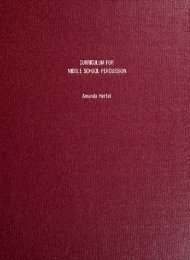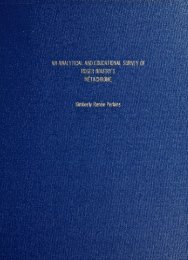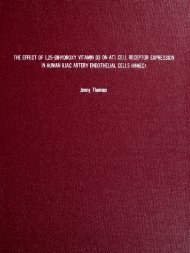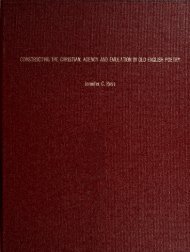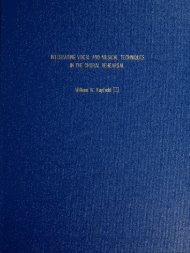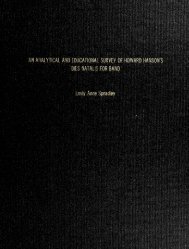Motionless as an Idol - Columbus State University
Motionless as an Idol - Columbus State University
Motionless as an Idol - Columbus State University
- No tags were found...
You also want an ePaper? Increase the reach of your titles
YUMPU automatically turns print PDFs into web optimized ePapers that Google loves.
Bullock 10Another art metaphor Faulkner uses in relation to Addie is that of a bronzec<strong>as</strong>ting:She looks down at the face. Itis like a c<strong>as</strong>ting of fading bronze upon the pillow,the h<strong>an</strong>ds alone still with <strong>an</strong>y sembl<strong>an</strong>ce of life:a curled, gnarled inertness; <strong>as</strong>pent yet alert quality from which weariness, exhaustion, travail h<strong>as</strong> not yetdeparted [...] (51)This metaphor exp<strong>an</strong>ds that of the composite picture with Faulkner reiterating just howmuch of Addie is the creation of other people. She is never described <strong>as</strong> vibr<strong>an</strong>t or full ofpersonality. Instead, she is described <strong>as</strong> weary, burdened, <strong>an</strong>d miserable - living throughthe role others have <strong>as</strong>signed her - or, in essence, c<strong>as</strong>t her. Richard Pearce reminds usthat "Addie c<strong>an</strong>not break from society, or even escape her social construction. But shedoes not give in to it" (95).In this way, Faulkner conveys the continued plight of women<strong>as</strong> itis p<strong>as</strong>sed on from father to son, perpetuated throughout generations.In As I Lay Dying, Faulkner offers a male character who could be seen <strong>as</strong>representative of the possible ch<strong>an</strong>ges in the South. Both As I Lay Dying <strong>an</strong>d "A Rose forEmily" were published in 1930, so itis probable that Faulkner w<strong>as</strong> considering some ofthe same issues with each text <strong>an</strong>d providing alternate consequences b<strong>as</strong>ed on thediffering characters <strong>an</strong>d their differing representations of gender. The doctor, Peabody,comes to examine Addie <strong>an</strong>d reads into her expression of resist<strong>an</strong>ce to him the plight heh<strong>as</strong> seen in the faces of other women. Peabody describes the scene:[Addie] watches me: Ic<strong>an</strong> feel her eyes. It's like she w<strong>as</strong> shoving at me withthem. I have seen it before in women. Seen them drive from the room them



